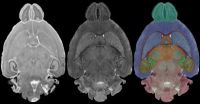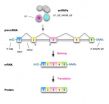Newer, more intense chemotherapy with less radiation not more effective against Hodgkin's lymphoma
Standard radiation plus ABVD chemotherapy still most effective against the disease
2010-10-26
(Press-News.org) A lower dose of radiation used to reduce side effects is not as effective as the regular dose when given with the standard chemotherapy in the treatment of Hodgkin's lymphoma patients with early, intermediate-stage disease, according to a first-of-its-kind randomized study presented at the plenary session, November 1, 2010, at the 52nd Annual Meeting of the American Society for Radiation Oncology (ASTRO).
In addition, the trial showed that a more intensive chemotherapy (BEACOPP) is not more effective than the standard chemotherapy treatment (ABVD) for these patients.
"This confirms that four cycles of ABVD, followed by 30 Gy involved field radiation therapy, should continue to be the standard treatment for early intermediate-stage Hodgkin's lymphoma patients," Hans Theodor Eich, M.D., Ph.D. lead author of the study and a radiation oncologist at the University of Cologne, in Cologne, Germany, said. "Prior to the study, it was unclear what the optimal chemotherapy regimen and the most effective dose of radiation was."
Chemotherapy followed by radiation treatment is the standard treatment for intermediate-stage Hodgkin's lymphoma. This group of patients has the disease in one or more lymph nodes on the same side of the diaphragm (the muscle under the lungs), along with other factors associated with a higher risk of the cancer spreading to other parts of the body.
Fortunately, cure rates among these Hodgkin's lymphomas, even those considered "unfavorable" as studied here, is very high. That is why doctors continue to experiment with treatment to maximize the chances for a cure while limiting the risks of long-term side effects.
This randomized study sought to determine the most effective dose of radiation for some Hodgkin's lymphoma patients. Researchers also examined whether a more intensive form of chemotherapy would improve the risk of cancer spreading, compared to the standard chemotherapy regime.
Between 1998 and 2003, 1,395 patients with untreated, early unfavorable Hodgkin's lymphoma were randomized into one of four treatment arms: the standard chemotherapy regime and radiation dose, the standard chemotherapy with a lower radiation dose, a more intensive chemotherapy regime with the standard radiation dose and the more intensive chemotherapy with a lower radiation dose.
Results of the study confirm that the standard chemotherapy, ABVD, used with the standard dose of radiation therapy, is the best treatment for patients with early, intermediate-stage Hodgkin's lymphoma. Findings also show that a more intensive chemotherapy, BEACOPP, is not more effective than the standard chemotherapy in treating this group of patients.
###
For more information on radiation therapy for lymphoma, visit www.rtanswers.org.
The abstract, "Intensified Chemotherapy and Dose-Reduced Involved Field Radiotherapy in Patients with Early Unfavorable Hodgkin Lymphoma: Final Analysis of the German Hodgkin Study Group (GHSG) randomized HD11 Trial," will be presented at the plenary session at 2:30 p.m. on Monday, November 1, 2010. To speak to the lead author of the study, Hans Theodor Eich, M.D., Ph.D., please call Beth Bukata or Nicole Napoli on October 31 – November 2, 2010, in the ASTRO Press Room at the San Diego Convention Center at 619-525-6313 or 619-525-6314. You may also e-mail them at bethb@astro.org or nicolen@astro.org.
END
ELSE PRESS RELEASES FROM THIS DATE:
2010-10-26
BOSTON (October 25, 2010) — Researchers from Tufts University pooled data from five previous epidemiological studies to investigate the prevalence of asthma in children in the Boston neighborhoods of Chinatown and Dorchester. Among children born in the United States, low socioeconomic status (SES) and exposure to pests (mice and cockroaches) were both associated with having asthma. Neither association was present in children born outside of the United States. The study was published online in advance of print in the Journal of Immigrant and Minority Health.
"In earlier ...
2010-10-26
Adding chemotherapy to radiation therapy for muscle invasive bladder cancer allows 67 percent of people to be free of disease in their bladders two years after treatment. This compares to 54 percent of people who receive radiation alone, according to the largest randomized study of its kind presented at the plenary session, November 1, 2010, at the 52nd Annual Meeting of the American Society for Radiation Oncology (ASTRO).
"The trial shows that this treatment offers improved control of cancer within the bladder with acceptable long-term side effects and is therefore a ...
2010-10-26
Stereotactic radiation is an effective, long-term treatment for trigeminal neuralgia: a painful condition that occurs with increased frequency in patients with multiple sclerosis (MS). Radiation is noninvasive and has less negative side effects than other treatments, according to the longest follow-up in a study of its kind presented October 31, 2010, at the 52nd Annual Meeting of the American Society for Radiation Oncology (ASTRO).
Multiple sclerosis is a progressive neurological disease affecting about 300,000 Americans where the body's immune system attacks its own ...
2010-10-26
Laxenburg, Austria – 26th October 2010 --
A new assessment of future scenarios that limit the extent of global warming cautions that unless current imbalances in R&D portfolios for the development of new, efficient, and clean energy technologies are redressed, greenhouse gas (GHG) emission reduction targets are unlikely to be met, or met only at considerable costs.
The study identifies energy efficiency as the single most important option for achieving significant and long-term reductions in GHG emissions, accounting for up to 50 percent of the reduction potential across ...
2010-10-26
ITHACA, N.Y. – The human hand is an amazing machine that can pick up, move and place objects easily, but for a robot, this "gripping" mechanism is a vexing challenge. Opting for simple elegance, researchers from Cornell University, University of Chicago and iRobot have bypassed traditional designs based around the human hand and fingers, and created a versatile gripper using everyday ground coffee and a latex party balloon.
They call it a universal gripper, as it conforms to the object it's grabbing rather than being designed for particular objects, said Hod Lipson, ...
2010-10-26
In scientific publishing, how much reuse of text is too much? Researchers at the Virginia Bioinformatics Institute at Virginia Tech and collaborators have shown that a computer-based text-searching tool is capable of unearthing questionable publication practices from thousands of full-text papers in the biomedical literature.
The first step in the process is to find out what is restated before zeroing in on who may have crossed an ethically unacceptable threshold. The findings, published in PLoS ONE, offer hope for curbing unethical scientific publication practice, ...
2010-10-26
VIDEO:
This video contains more on the pediatric bone cancer preclinical study.
Click here for more information.
BOSTON - Researchers have identified an important signaling pathway that, when blocked, significantly decreases the spread of pediatric bone cancer.
In their study, researchers at The University of Texas MD Anderson Children's Cancer Hospital in Houston found that blocking the Notch pathway in mice decreased metastases in the lungs 15-fold. The results of ...
2010-10-26
DURHAM, N.C. – The most detailed magnetic resonance images ever obtained of a mammalian brain are now available to researchers in a free, online atlas of an ultra-high-resolution mouse brain, thanks to work at the Duke Center for In Vivo Microscopy.
In a typical clinical MRI scan, each pixel in the image represents a cube of tissue, called a voxel, which is typically 1x1x3 millimeters. "The atlas images, however, are more than 300,000 times higher resolution than an MRI scan, with voxels that are 20 micrometers on a side," said G. Allan Johnson, Ph.D., who heads the ...
2010-10-26
PHILADELPHIA - When most genes are transcribed, the nascent RNAs they produce are not quite ready to be translated into proteins - they have to be processed first. One of those processes is called splicing, a mechanism by which non-coding gene sequences are removed and the remaining protein-coding sequences are joined together to form a final, mature messenger RNA (mRNA), which contains the recipe for making a protein.
For years, researchers have understood the roles played by the molecular machines that carry out the splicing process. But, as it turns out, one of those ...
2010-10-26
Even if a woman is perfectly clear in expressing sexual interest or rejection, young men vary in their ability to remember the cues, a new University of Iowa study shows.
Overall, college-age men were quite good at recalling whether their female peers – in this case, represented through photos – showed interest. Their memories were especially sharp if the model happened to be good looking, dressed more provocatively, and conveyed interest through an inviting expression or posture.
But as researchers examined variations in sexual-cue recall, they found two noteworthy ...
LAST 30 PRESS RELEASES:
[Press-News.org] Newer, more intense chemotherapy with less radiation not more effective against Hodgkin's lymphoma
Standard radiation plus ABVD chemotherapy still most effective against the disease


